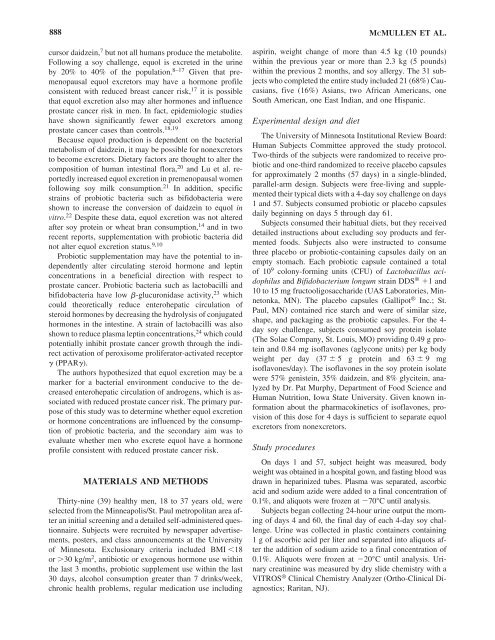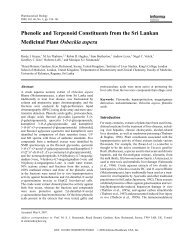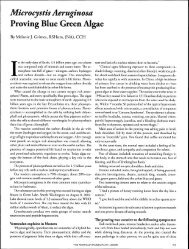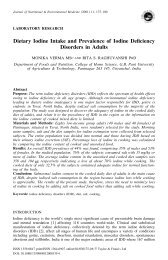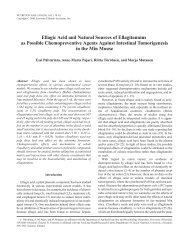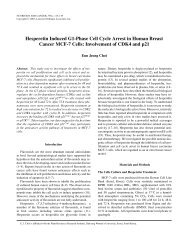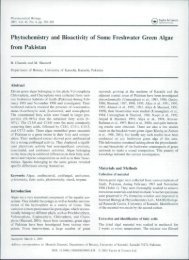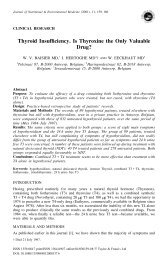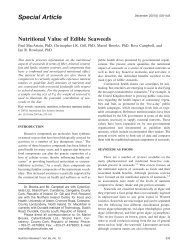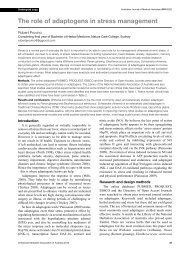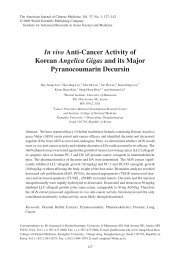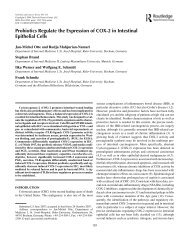Consumption of Lactobacillus acidophilus and Bifidobacterium ...
Consumption of Lactobacillus acidophilus and Bifidobacterium ...
Consumption of Lactobacillus acidophilus and Bifidobacterium ...
- No tags were found...
You also want an ePaper? Increase the reach of your titles
YUMPU automatically turns print PDFs into web optimized ePapers that Google loves.
888cursor daidzein, 7 but not all humans produce the metabolite.Following a soy challenge, equol is excreted in the urineby 20% to 40% <strong>of</strong> the population. 8–17 Given that premenopausalequol excretors may have a hormone pr<strong>of</strong>ileconsistent with reduced breast cancer risk, 17 it is possiblethat equol excretion also may alter hormones <strong>and</strong> influenceprostate cancer risk in men. In fact, epidemiologic studieshave shown significantly fewer equol excretors amongprostate cancer cases than controls. 18,19Because equol production is dependent on the bacterialmetabolism <strong>of</strong> daidzein, it may be possible for nonexcretorsto become excretors. Dietary factors are thought to alter thecomposition <strong>of</strong> human intestinal flora, 20 <strong>and</strong> Lu et al. reportedlyincreased equol excretion in premenopausal womenfollowing soy milk consumption. 21 In addition, specificstrains <strong>of</strong> probiotic bacteria such as bifidobacteria wereshown to increase the conversion <strong>of</strong> daidzein to equol invitro. 22 Despite these data, equol excretion was not alteredafter soy protein or wheat bran consumption, 14 <strong>and</strong> in tworecent reports, supplementation with probiotic bacteria didnot alter equol excretion status. 9,10Probiotic supplementation may have the potential to independentlyalter circulating steroid hormone <strong>and</strong> leptinconcentrations in a beneficial direction with respect toprostate cancer. Probiotic bacteria such as lactobacilli <strong>and</strong>bifidobacteria have low -glucuronidase activity, 23 whichcould theoretically reduce enterohepatic circulation <strong>of</strong>steroid hormones by decreasing the hydrolysis <strong>of</strong> conjugatedhormones in the intestine. A strain <strong>of</strong> lactobacilli was alsoshown to reduce plasma leptin concentrations, 24 which couldpotentially inhibit prostate cancer growth through the indirectactivation <strong>of</strong> peroxisome proliferator-activated receptor (PPAR).The authors hypothesized that equol excretion may be amarker for a bacterial environment conducive to the decreasedenterohepatic circulation <strong>of</strong> <strong>and</strong>rogens, which is associatedwith reduced prostate cancer risk. The primary purpose<strong>of</strong> this study was to determine whether equol excretionor hormone concentrations are influenced by the consumption<strong>of</strong> probiotic bacteria, <strong>and</strong> the secondary aim was toevaluate whether men who excrete equol have a hormonepr<strong>of</strong>ile consistent with reduced prostate cancer risk.MATERIALS AND METHODSThirty-nine (39) healthy men, 18 to 37 years old, wereselected from the Minneapolis/St. Paul metropolitan area afteran initial screening <strong>and</strong> a detailed self-administered questionnaire.Subjects were recruited by newspaper advertisements,posters, <strong>and</strong> class announcements at the University<strong>of</strong> Minnesota. Exclusionary criteria included BMI 18or 30 kg/m 2 , antibiotic or exogenous hormone use withinthe last 3 months, probiotic supplement use within the last30 days, alcohol consumption greater than 7 drinks/week,chronic health problems, regular medication use includingaspirin, weight change <strong>of</strong> more than 4.5 kg (10 pounds)within the previous year or more than 2.3 kg (5 pounds)within the previous 2 months, <strong>and</strong> soy allergy. The 31 subjectswho completed the entire study included 21 (68%) Caucasians,five (16%) Asians, two African Americans, oneSouth American, one East Indian, <strong>and</strong> one Hispanic.Experimental design <strong>and</strong> dietThe University <strong>of</strong> Minnesota Institutional Review Board:Human Subjects Committee approved the study protocol.Two-thirds <strong>of</strong> the subjects were r<strong>and</strong>omized to receive probiotic<strong>and</strong> one-third r<strong>and</strong>omized to receive placebo capsulesfor approximately 2 months (57 days) in a single-blinded,parallel-arm design. Subjects were free-living <strong>and</strong> supplementedtheir typical diets with a 4-day soy challenge on days1 <strong>and</strong> 57. Subjects consumed probiotic or placebo capsulesdaily beginning on days 5 through day 61.Subjects consumed their habitual diets, but they receiveddetailed instructions about excluding soy products <strong>and</strong> fermentedfoods. Subjects also were instructed to consumethree placebo or probiotic-containing capsules daily on anempty stomach. Each probiotic capsule contained a total<strong>of</strong> 10 9 colony-forming units (CFU) <strong>of</strong> <strong>Lactobacillus</strong> <strong>acidophilus</strong><strong>and</strong> <strong>Bifidobacterium</strong> longum strain DDS ® 1 <strong>and</strong>10 to 15 mg fructooligosaccharide (UAS Laboratories, Minnetonka,MN). The placebo capsules (Gallipot ® Inc.; St.Paul, MN) contained rice starch <strong>and</strong> were <strong>of</strong> similar size,shape, <strong>and</strong> packaging as the probiotic capsules. For the 4-day soy challenge, subjects consumed soy protein isolate(The Solae Company, St. Louis, MO) providing 0.49 g protein<strong>and</strong> 0.84 mg is<strong>of</strong>lavones (aglycone units) per kg bodyweight per day (37 5 g protein <strong>and</strong> 63 9 mgis<strong>of</strong>lavones/day). The is<strong>of</strong>lavones in the soy protein isolatewere 57% genistein, 35% daidzein, <strong>and</strong> 8% glycitein, analyzedby Dr. Pat Murphy, Department <strong>of</strong> Food Science <strong>and</strong>Human Nutrition, Iowa State University. Given known informationabout the pharmacokinetics <strong>of</strong> is<strong>of</strong>lavones, provision<strong>of</strong> this dose for 4 days is sufficient to separate equolexcretors from nonexcretors.Study proceduresMCMULLEN ET AL.On days 1 <strong>and</strong> 57, subject height was measured, bodyweight was obtained in a hospital gown, <strong>and</strong> fasting blood wasdrawn in heparinized tubes. Plasma was separated, ascorbicacid <strong>and</strong> sodium azide were added to a final concentration <strong>of</strong>0.1%, <strong>and</strong> aliquots were frozen at 70°C until analysis.Subjects began collecting 24-hour urine output the morning<strong>of</strong> days 4 <strong>and</strong> 60, the final day <strong>of</strong> each 4-day soy challenge.Urine was collected in plastic containers containing1 g <strong>of</strong> ascorbic acid per liter <strong>and</strong> separated into aliquots afterthe addition <strong>of</strong> sodium azide to a final concentration <strong>of</strong>0.1%. Aliquots were frozen at 20°C until analysis. Urinarycreatinine was measured by dry slide chemistry with aVITROS ® Clinical Chemistry Analyzer (Ortho-Clinical Diagnostics;Raritan, NJ).


